

Galilée. Il a vécu au temps de la Renaissance.
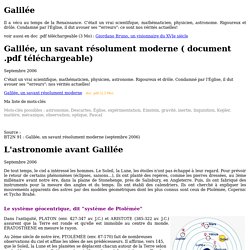
C'était un vrai scientifique, mathématicien, physicien, astronome. Rigoureux et drôle. Condamné par l'Église, il dut avouer ses '"erreurs": ce sont nos vérités actuelles! C'était un vrai scientifique, mathématicien, physicien, astronome. Rigoureux et drôle. Galilée, un savant résolument moderne doc .pdf (2,3 Mo) Atelier : la recette du papier recyclé. Matériel des vieux journauxdes cadresde la moustiquaire finedes chiffonsdes éponges classiquesune grande éponge platedes rouleaux à pâtisserieune bassineun batteur dédié à cette activité.
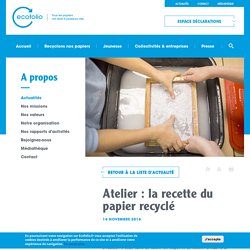
Scientists Develop Bioplastic From Food Scraps. Plastic has been an amazing resource for humans, but it has also generated a considerable amount of waste that poses a serious threat to wildlife.
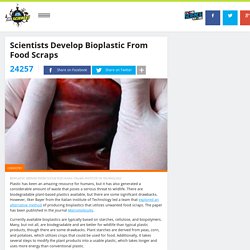
There are biodegradable plant-based plastics available, but there are some significant drawbacks. However, Ilker Bayer from the Italian Institute of Technology led a team that explored an alternative method of producing bioplastics that utilizes unwanted food scraps. The paper has been published in the journal Macromolecules. Currently available bioplastics are typically based on starches, cellulose, and biopolymers. Making Paper from Seaweed: Papermaking with Atlantic BioInvader Codium Fragile.
“Papermaking with Atlantic BioInvader Codium Fragile” is a guest post by papermaking artist and sculptor Megan Singleton, who completed an artist residency in Chatham, MA.
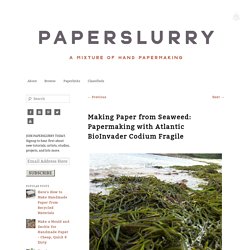
Originally featured on Aldo & Leonardo, (A Wilderness Science and Art Collaboration) these are Megan’s musings on making paper and art from a common invasive seaweed on Cape Cod. And without further ado… The relationships that exist within the natural world inspire me. A large part of my studio practice is exploring the materiality and transformative properties of plants, specifically I investigate invasive plants and their impact within the ecosystems they are invading. The first day I arrived on Cape Cod I encountered Codium fragile, commonly known as “Deadman’s Fingers” or “Green Fleece”. The papermaking process for me begins with exploring sites that are being affected by invasive species and collecting plants. 1. 3. From Your Kitchen to Your Studio: At Home Botanical Dyes. Our first natural dye tutorial focused on extracting cochineal dye purchased from a supplier.

Whether you’re new to naturally dyeing handmade paper or looking to expand your color range, potential dyestuff might live closer than you think—you can extract dyes from items found in your kitchen. Wednes-DIY: Making Natural Dyes – Free People Blog. Pin It I have been wanting to experiment with natural dyes for a while now, and with all the great new fall colors that have been popping up on our website (and featured in our monochromatic trend) I decided that it was time.

This is such a fun, environmentally friendly project that takes a little time, but very little cash. For today’s DIY I’ll tell you about what natural ingredients you can use to make natural dyes, and what shades of color they will yield. What I got: red cabbage, lemons, oranges, beets, yellow onions, blackberries, blueberries, spinach. [Vidéo] Quand le MIT s'inspire des castors pour concevoir des combinaisons de surf. Une équipe de chercheurs du MIT s'est inspirée de la méthode d'isolation qu'utilisent les castors et les loutres des mers pour développer des combinaisons de surf plus performantes.
![[Vidéo] Quand le MIT s'inspire des castors pour concevoir des combinaisons de surf](http://cdn.pearltrees.com/s/pic/th/inspire-concevoir-combinaisons-144976374)
Ces petits mammifères semi-aquatiques savent restés au chaud tout en conservant leur agilité. Deux caractéristiques clés pour une combinaison. Comment rendre les combinaisons des surfeurs plus isolantes sans entraver leurs mouvements ? Pour résoudre cette problématique, le fabricant de combinaison Sheico Group, s'est rapproché d'une équipe de chercheurs du MIT. Ces derniers se sont inspirés de la nature pour proposer une réponse pertinente. Untitled Document. Sans titre. Mélanine et absorption des UV en SL. Dans cette séance, nous avons voulu montrer que la mélanine de la peau protège des rayons UV Matériel et ressources : Lampe UV et son enceinte Pastilles sensibles aux UV Champignons de Paris Tyrosine gélose De la mélanine peut être produite à partir du champignon de Paris, suivant un protocole assez classique dans des TP d’enzymologie : exemple de protocole.
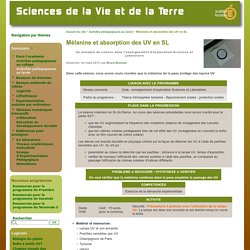
Nous avons travaillé à froid pour l’extraction et nous avons agité énergiquement les tubes pour augmenter l’oxygénation du milieu, des étapes de la synthèse nécessitant de l’oxygène. METHODES ET PRATIQUES SCIENTIFIQUES. SVT - Lycée Jaufré Rudel - Blaye - RR. Lycée Franco-Hellénique Eugène Delacroix - CAHIER DE TEXTE.
Muséum d'histoire naturelle - Ressources MPS. Raisin et vin (MPS) Artists Materials - Pigments from the Earth: Part 1 - Natural Pigments. Finding and collecting earth pigments can be both exciting and rewarding endeavor.
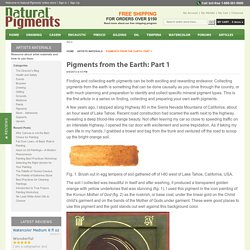
Collecting pigments from the earth is something that can be done causally as you drive through the country, or with much planning and preparation to identify and collect specific mineral pigment types. This is the first article in a series on finding, collecting and preparing your own earth pigments. A few years ago, I stopped along Highway 80 in the Sierra Nevada Mountains of California, about an hour west of Lake Tahoe.
Recent road construction had scarred the earth next to the highway, revealing a deep blood-like orange beauty. Not often leaving my car so close to speeding traffic on an interstate highway, I opened the car door with excitement and some trepidation. Fig. 1. The soil I collected was beautiful in itself and after washing, it produced a transparent golden orange with yellow undertones that was stunning (fig. 1). Fig. 2. Fig. 3. Léonard de Vinci - La belle princesse.